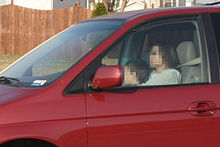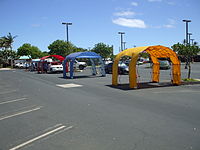- Child safety seat
-
Child safety seats (sometimes referred to as an infant safety seat, a child restraint system, a restraint car seat, or ambiguously as car seats) are seats designed specifically to protect children from injury or death during collisions. Automobile manufacturers may integrate child safety seats directly into their vehicle's design. Most commonly, these seats are purchased and installed by consumers. Many regions require children defined by age, weight, and/or height to use a government-approved child safety seat when riding in a vehicle. Child safety seats provide passive restraints and must be properly used to be effective.
Contents
History
After the first automobile was manufactured and put on the market in the early 1900s, many modifications and adjustments have been implemented to protect those that drive and ride in these vehicles. Most restraints were put into place to protect adults without regard for children, infant through pre-school age. Though child seats were beginning to be manufactured in the early 1930s, their purpose was not the safety of children. The purpose was to act as booster seats to bring the child to a height easier for the driving parent to see them. It wasn’t until 1962 that seats were invented with the purpose of protecting a child, by Leonard Rivkin, of Denver Colorado.[1]
Law
United States of America
As a result of these statistics, it is required by law the children under the age of seven be secured in safety seats made for children under forty pounds in all U.S. states and territories. Also, all states require booster seats for children aged four to fourteen depending upon each individual child's age, weight, height, and state. Note that these laws are basic guidelines only and can differ state to state, because each state has some variance in the laws.
Australia
As in the United States road rules are at the command of each separate state or territory. In Victoria a child must be correctly restrained until 7 years of age, using each of the three seats described below.
Manufacturing
Though there are hundreds of variations of makes and models in the world of child safety seats, the materials used in the manufacturing process are basically the same. Factories in which the seats are put together receive loads of polypropylene pellets.[2] Foam makes up the padding of the individual seats, while vinyl and fabrics are used to make up the covers for the seats as well as the harnesses. Among all these products used to make one child safety seat, none are as important as the labels each manufacturer prints according to Federal standards.
A safety seat increase the safety of a properly restrained child in the case of a motor vehicle accident. The safety seat includes foam padding, fabric covers, a harness, and buckles or attaching mechanisms. Labels and instructions are also attached.
Types
All child safety seats are made same process, however there are different types of seats for children of different size and age with specific guidelines as to how they should be used.
- Infant seats - From the time a child is born, they must always ride in an infant seat which is most well known as a rear-facing infant seat. These seats are designed for a baby that is under twenty pounds and should always remain facing the rear of a vehicle. Seats made specifically for infants are the smallest and have carrying handles for easy carrying and loading. They can be used until the infant is up to 10 through 14.5 kg (22 to 32 lbs.) depending on the instructions specified on each individual model.
- Convertible seats - Similar to the infant carrier, the second kind of car seat is the convertible. This seat can be used in a rear- or forward-facing position and is used for children typically beginning at 5 pounds up to 50 pounds. The rear-facing position is used for children who have not exceeded at minimum 20 pounds and are at least one year old. Some new model seats however, allow your child to stay rear-facing until 35 pounds. Once the child has reached the minimum requirements to be forward facing; the seat then can be turned around and used until the maximum weight is exceeded on the seat. [3]There are typically no age parameters around which type of seat to use; it is primarily about the weight of the child.
- Combination seats - Next in the car seat progression is the 5 point booster; or combination. This is a forward-facing-only seat and has the 5 point harnessing system for children under 40 pounds. This seat is not recommended for use on children under 20 pounds. Usually at 30 pounds a child can transition into this seat. New models also allow the 5 point harnessing system to go up to 55 and even 65 pounds depending on the manufacturer. Once the child has exceeded the maximum weight allowance for the 5 point restraint system; the webbing can be removed and now you have a belt positioning booster. [4]
- Booster seats - The earlier described combination seat can become a high back belt positioning booster. There is also a high back belt positioning booster that is available for that purpose only. The other type of belt positioning booster is the low back or no back booster. The major differences between the low and high back booster seats are head support. If your vehicle has bench seating and no headrest is supplied by the vehicle; you are required to use a high back booster. The purpose of the booster seats is to provide elevation to the child so the shoulder belt rests appropriately on the shoulder blade and does not ride up the child’s neck. It also provides “hips” that the seat belt can rest securely across and remain on the large bones of the child instead of resting across the soft tissue of the abdomen. This seat is available for children over 40 pounds up to over 100 pounds. [5]From the ages of eight to twelve, children may have outgrown their booster seats and can be permitted to use regular adult seat restraints. It is suggested that, until the age of thirteen, the child remains in the back seat.
Hazards
Manufacturers have quality controls to ensure seats are properly put together and packaged. However, it is not guaranteed that the included instructions are always adhered to and correctly followed. Up to 95% of the safety seats that are installed may not be the right seat for the child, may be hooked into the vehicle loosely, may be hooked with an incompatible belt in the vehicle, may have harnesses incorrectly fastened in some way, or may be incorrectly placed in front of air bags. In 1997, six out of ten children who were killed in vehicle crashes were not correctly restrained.[2]
Along with the problem of instructions not being followed properly, there are other hazards that can affect children involving these safety seats. A recent study[clarification needed] attributed many cases of sudden infant death syndrome (SIDS) to the prolonged sitting or lying position these infants are in when putting the safety seats to use. When researchers reviewed more than 500 infant deaths, it was found that 17 of these deaths occurred while the infant was in a device such as a child safety seat. The age of the most occurring rates of death by SIDS in a child safety device was found to be under one month, having six of the 17 deaths happen in this age group. Although SIDS has been found to be a high risk regarding child safety seats, a coroner in Quebec also stated that “putting infants in car seats…causes breathing problems and should be discouraged."[6] His warning came after the death of a two-month-old boy who was left to nap in a child safety seat positioned inside his crib rather than the crib itself. The death was linked to positional asphyxiation.[6] This means that the child was in a position causing him to slowly lose his supply of oxygen. The coroner said that it is common for a baby’s head to “slump forward while in a car seat and that it diminishes oxygen”.[6] It is recommended for drivers to make frequent stops during trips to prevent an infant sitting in a slumped forward position for any length of time. These are just a small example of the many things that could possibly go wrong with any child safety seat. It is suggestible that every parent look into the product they are buying to gain knowledge of how they work and the ratings they have received. Some resources that can be used for this include The Latch Manual which demonstrates the knowledge of installing different child restraints, newsletters such as “Safe Riders News”, and fact sheets that can be printed offline as PDF files, etc.
References
- ^ USPTO. "United States Patent and Trademark Office" USPTO Full-Text and Image Database. Patent #3,107,942. Filed March 5, 1962 <http://patft.uspto.gov>.
- ^ a b AAP. "Car Safety Seats: A Guide For Families 2009." American Academy of Pediatrics. 2009. American Academy of Pediatrics. 22 Feb. 2009 <http://www.aap.org//.htm>.
- ^ NHTSA. "National Child Passenger Safety Certification Training Program Manual." Safe Kids Worldwide, April 2007.
- ^ NHTSA. "National Child Passenger Safety Certification Training Program Manual." Safe Kids Worldwide, April 2007.
- ^ NHTSA. "National Child Passenger Safety Certification Training Program Manual." Safe Kids Worldwide, April 2007.
- ^ a b c “Child Safety Seat.” How Products Are Made. 2008. How It’s Made. 22 Feb. 2009 <http://www.madehow.com/Volume-5/Child-Safety-Seat.html>.
Baby monitor · Child harness · Child safety lock · Child safety seat · Childproofing · Child-resistant packaging · Infant car seat · Infant bed · Kiddy Bag · Playpen · Pool fence · School bus crossing arm · Toddler bed · Trigger lock
Categories:- Child safety
Wikimedia Foundation. 2010.




